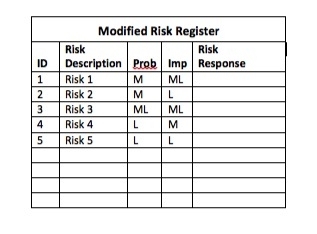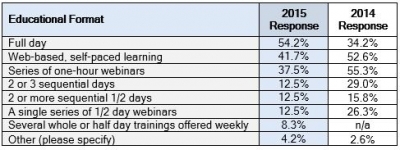
The Chief Operating Officer (COO) asks the Chief Executive Officer (CEO): “What if we spend time and money training our employees and they leave the company?”
The CEO responds: “What if we don’t and they stay?”
Taking time and resources to train your personnel is often looked at as a necessary evil. Training employees takes them away from their day-to-day tasks and the cost will be reflected on the bottom line. Adding to the challenge of supporting training, is the uncertainty of the return-on-investment at both an individual and organizational productivity level.
As an executive who is considering training your team, the most important question you should ask is not: Should I train my team? but rather: What method of training should I use? Different training methods result in varying levels of content retention. Of course you want to ensure that your organization achieves the greatest value from training, so relevant content as well as deploying the use of experiential learning techniques should both be priorities.
 As the image to the left illustrates, participatory learning, especially using simulation for practice, provides the highest level of retention for training, second only to “teaching others.”
As the image to the left illustrates, participatory learning, especially using simulation for practice, provides the highest level of retention for training, second only to “teaching others.”What is simulation-based learning? It is an instructor-guided, interactive learning environment that replicates an actual business, technical, or educational challenge. It permits the learners to practice resolving issues in a relatively worry-free atmosphere. Not only is it authentic and relevant to the learners’ work, but it provides a safe environment to learn; mistakes won’t result in costly repercussions. It’s ideal to spur on innovation, too, because it allows for creative problem solving.
Simulation-based learning is the most effective technique for developing every professionals’ knowledge, skills, and attitudes, whilst protecting the organization from unnecessary risks. It is useful in resolving practical dilemmas, and provides four real-time benefits.
- EXPERIENTIAL & REPETITIVE LEARNING. While in traditional lecture-based training, the desired outcome is merely explained; in simulation learning, individuals achieve an outcome from first-hand experience. Adults, like most people, learn better through experience. In the simulation, individuals have the opportunity for repetitive practice, which helps increases retention.
- KNOWLEDGE INTEGRATION. A key facet of any learning is that understanding is increased when it is linked to some already known piece of knowledge. Simulation-based learning, because of its participatory nature, has the added benefit of being able to psychologically link concepts and allow participants to link knowledge areas through their actions.
- RISK-FREE LEARNING ENVIRONMENT. Regardless of our attitude, learning research validates that we learn by making mistakes. In fact, they are invaluable to the participant. If executive decision makers can participate in relevant and realistic simulations, they can safely make mistakes, learn from them, and promptly apply their learned knowledge to their real work challenges, avoiding costly mistakes or unintended consequences.
- ABILITY TO ADJUST THE LEVEL OF DIFFICULTY. The technology provided in most simulation-based learning tools are designed to allow the difficulty level to increase as the competency of the individuals and teams improve. This provides additional flexibility and continual learning opportunities for a varied level of experienced personnel.
Simulation-based learning is the most effective learning technique for both your employees and your organization. Your training dollars are better invested with simulation training because of higher learning retention. Further, because your team will practice with relevant and practical scenarios, the potential for catastrophic mistakes is mitigated.
If you’re looking for a relevant, engaging interactive learning environment with simulation, call Merit and ask about our SimulTrain® project management training experience. Contact Jim Wynne at jwynne@meritcd.com or call him at 610-225-0449.
 Standard risk responses include Avoidance, Mitigation, Transference, and Acceptance (passive/active). At Merit, we developed a reporting process that would show that the risk factors were decreasing as the project progressed. Supplemented with suitable risk responses, the true reduction of risk probability occurs over time.
Standard risk responses include Avoidance, Mitigation, Transference, and Acceptance (passive/active). At Merit, we developed a reporting process that would show that the risk factors were decreasing as the project progressed. Supplemented with suitable risk responses, the true reduction of risk probability occurs over time. The Probability and Impact Matrix is one of the tools that we recommend in a risk management strategy. It is superimposed with risks that are labeled or numbered as in the above example. “Red” area risks were uniquely documented on a trending month-to-month basis such that it could be seen “driving” toward zero.
The Probability and Impact Matrix is one of the tools that we recommend in a risk management strategy. It is superimposed with risks that are labeled or numbered as in the above example. “Red” area risks were uniquely documented on a trending month-to-month basis such that it could be seen “driving” toward zero.
 Studies show that lack of EQ may limit a person’s ability to achieve results. Lower EQ scores correlate with lower merit pay increases, lower job satisfaction and more burnout. Managers’ and supervisors’ EQ scores correlate with their performance ratings.
Studies show that lack of EQ may limit a person’s ability to achieve results. Lower EQ scores correlate with lower merit pay increases, lower job satisfaction and more burnout. Managers’ and supervisors’ EQ scores correlate with their performance ratings. We all have specific words or phrases that are steeped in emotion. During the 1960s and 70s, the term “nuclear power” raised a great deal of emotion—both positive and negative. Similarly today we have emotionally charged words or phrases such as “gun control”, terrorism, and consumer privacy. It is important to recognize one’s own emotionally charged phrases and stop the emotional hijacking that is about to take place.
We all have specific words or phrases that are steeped in emotion. During the 1960s and 70s, the term “nuclear power” raised a great deal of emotion—both positive and negative. Similarly today we have emotionally charged words or phrases such as “gun control”, terrorism, and consumer privacy. It is important to recognize one’s own emotionally charged phrases and stop the emotional hijacking that is about to take place.

 The basis for choosing a course and provider were measured differently last year, but in both instances, the primary driver is the course topic and/or area that most needs development, followed by convenience of timing, and location. The program cost was lower in priority. See Q3 chart on the left for details.
The basis for choosing a course and provider were measured differently last year, but in both instances, the primary driver is the course topic and/or area that most needs development, followed by convenience of timing, and location. The program cost was lower in priority. See Q3 chart on the left for details. The CrossFit program was developed to enhance an individual’s competency at all physical tasks. Athletes are trained to perform at multiple, diverse, and randomized physical challenges. This type of fitness is demanded of military and police personnel, firefighters, and many sports requiring overall physical prowess.
The CrossFit program was developed to enhance an individual’s competency at all physical tasks. Athletes are trained to perform at multiple, diverse, and randomized physical challenges. This type of fitness is demanded of military and police personnel, firefighters, and many sports requiring overall physical prowess. How can crossfit training your mind benefit you in your workplace? Cross-functional training has many benefits for organizations as well as employees. At an organizational level, cross training skillsets help safeguard the organization against widening skills gaps. Organizations that cross-train employees across a range of functions put themselves in a good position to prevent sudden shortfalls and manage surges in specific areas when there is a spike in demand. On an individual level, cross training enables employees to explore and assess alternative interests and abilities. It also enables managers to identify and nurture employees who show exceptional talent in a particular function. Cross-training yourself to learn new skills, can increase your employability and enable you to stay relevant.
How can crossfit training your mind benefit you in your workplace? Cross-functional training has many benefits for organizations as well as employees. At an organizational level, cross training skillsets help safeguard the organization against widening skills gaps. Organizations that cross-train employees across a range of functions put themselves in a good position to prevent sudden shortfalls and manage surges in specific areas when there is a spike in demand. On an individual level, cross training enables employees to explore and assess alternative interests and abilities. It also enables managers to identify and nurture employees who show exceptional talent in a particular function. Cross-training yourself to learn new skills, can increase your employability and enable you to stay relevant.
 Why do we work at Merit:
Why do we work at Merit: From emotions to the time of day, it is often the little things that impact our ability to make a swift and accurate decision. A range of factors can compound the challenges in making good choices, both directly and indirectly.
From emotions to the time of day, it is often the little things that impact our ability to make a swift and accurate decision. A range of factors can compound the challenges in making good choices, both directly and indirectly. Even the most carefully planned project can run into trouble. Unanticipated weather problems can disrupt the logistics of construction projects, a key software developer quits to take new jobs or an engineer underestimates the time needed to implement components of a production line. Whatever the issue, the challenge of finding a solution falls to the project manager (PM).
Even the most carefully planned project can run into trouble. Unanticipated weather problems can disrupt the logistics of construction projects, a key software developer quits to take new jobs or an engineer underestimates the time needed to implement components of a production line. Whatever the issue, the challenge of finding a solution falls to the project manager (PM).